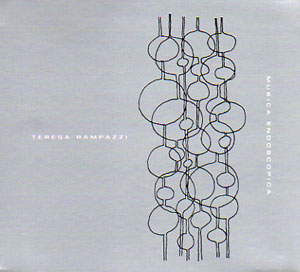The deeper you delve into the history of electronic music, it sometimes seems, the further time, culture and technology recede as considerations. Regardless of methodology or geography, common impulses and themes recur, belying the fantasies of linear progress often put forward most dogmatically by the music’s creators.
From our distance, it would be easy to see electronic composer Teresa Rampazzi as Italy’s equivalent of Daphne Oram or Delia Derbyshire, those long-neglected pioneers behind the BBC Radiophonic Workshop. Zoom in closer, though, and a more intriguing picture begins to emerge. The four pieces collected here were recorded between 1970 and 1980, when Rampazzi was in her late 50s and early 60s, and — incredibly — this is the first time they’ve ever been released. While her ideas followed broadly on from those of John Cage (with whom she’d performed) and the generation of European composers who passed through the Darmstadt School, the sophistication of her sound, and her knack for anticipating key traits that would define the electronic ‘innovative’ at various points during the ensuing decades, are nonetheless remarkable. More importantly, Musica Endoscopica is not just a fascinating artefact — it’s a wonderful album in its own right.
In 1965, Rampazzi co-founded the NPS (Nuove Proposte Sonore — roughly, "proposed new sound"), a group who pledged to abandon the tape manipulation techniques of musique concrète and to develop instead electronic sound-generating devices from whatever odds and ends they could lay their hands on. They recorded anonymously, consistent with the aims outlined in their manifesto: "[to avoid] free, informal creativity, to strive for formalised form instead", to refuse emotional subjectivity, and so on. These principles couldn’t contain the individual talents at work for long, though, and one of the first pieces to be credited to its sole composer opens this collection.
Rampazzi identified ‘Environ’ as "a piece of ambient music" long before Brian Eno put his signature to the idea. Designed "as a musical background for an architectural space," it’s certainly among the earliest pieces of electronic music to recognise the potential of ambient as a genre; still, it might be too engaging, too labyrinthine, to really suit the term. In a blind listening test, these high-resolution timbres might sound to us like a sophisticated update of Walter/Wendy Carlos’s soundscapes for A Clockwork Orange or the lo-fi black seas created by Neu! — both of which they actually pre-dated by a couple of years. There’s nothing organic, but something very human about this series of tone clusters (those things often used on film soundtracks when someone’s been slipped a Mickey or there’s about to be a murder) and their myriad, impossible textures as they build and fade. All the more remarkable when you consider the painstaking and lengthy processes that produced them.
If exhuming the soundtrack to footage of an Italian gastroscopy from the 1970s strikes you as barrel-scraping by people who’ve run out of proper records to discover ("they’ve spent so much time exploring their own arseholes, they’ve had to go all the way into the duodenum!"), think again. Composed for the documentary Gastroscopia in 1972, the 12-part ‘Musica Endoscopica’ sounds appropriately fleshly and alien. Each stage realises its subject in appealing and ingenious ways. ‘Fibre Ottiche’ ("optical fibre") is a suitably taut and textured entry point. The echoey ‘Laringe’ ("larynx") captures sonorous speech without legible language, as if heard from inside the body. ‘Stomaco’ (guess) swathes irregular bangs in reverb to soften the alarm, suggesting a mysterious but trustworthy inner process we spend most of our lives unaware of.
It’s tempting to see Rampazzi’s approach as being partly the result of gender and maturity. The sense is that the really fascinating, frightening stuff is happening inside us right now; a marked contrast to the outer space-obsessed, man-machine musician of electro lore. But this journey through the inner workings of the body creates a similarly giddy feel as Basic Channel, Chain Reaction and some of the first minimal records. It also establishes a niche that Herbert (on Bodily Functions) and Matmos (on A Chance to Cut Is a Chance to Cure) would revisit at the beginning of the 2000s with their manipulation of sampled bodily/medical processes into pop songs. That’s pretty much an all-male cast.
In 1972, Rampazzi effectively dissolved the NPS when she went to teach at the Padova Conservotoire and took their equipment with her. Once there, she began to grapple with the university’s administrative computers — bulky machines that received and released data on punched cards — to musical ends, assiduously developing new software to make the process easier. She used it to create a kind of virtual tintinnabulation in clustered tones: a completely realised, impossible sound world with no cracks or joins. The two products of this era included here stand out from any other electronic music I’ve heard.
The closest cousin to the mind-blowing ‘With The Light Pen’ might be Aphex Twin’s best ambient work. Every "Bong!" is tweaked into a bizarre shape — she’s arrested time, fiddled with attack and delay at the atomic level. But it’s ‘Atmen Noch’ that really towers; it’s like wondering through a corridor of chiming Dalí clocks. By the eleven-minute mark, the chimes sound washed by acid, but even more impactful — clearer than a bell. In preparation for this piece, Rampazzi spent five months researching how she could manipulate timbres through means I’m too impatient to really understand; perhaps it shouldn’t be a surprise that it outstrips our laptop-wielding producers, or indeed anything by Harmonia, Kraftwerk and Cluster, her contemporaries on the other side of the European pop tracks.
Rampazzi doesn’t have the nostalgic pull of the Radiophonic Workshop; she made her innovations in academic circles rather than in the midst of popular culture. But the pieces collected on Musica Endoscopica are ultimately more satisfying — timelessly, wondrously strange, in a way few pioneering electronic works still sound.
Musica Endoscopica _is available from the Die Schachtel website._


